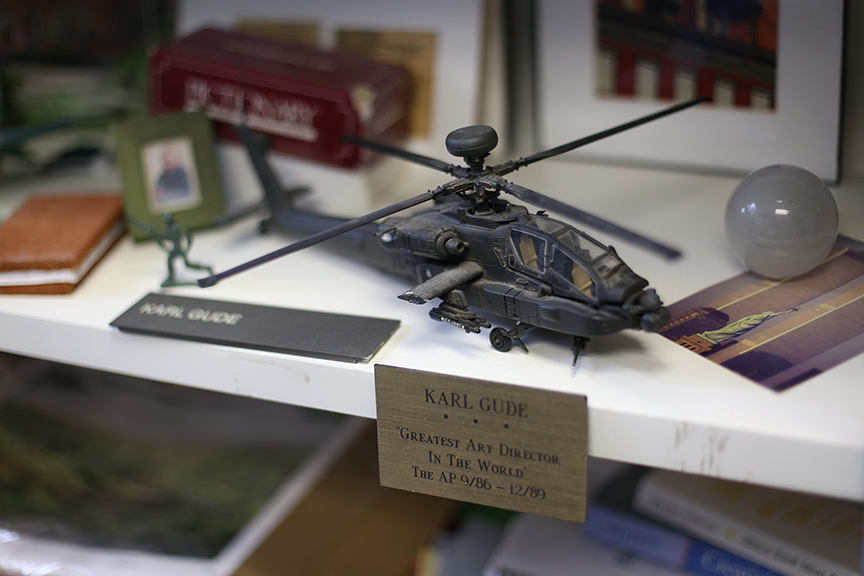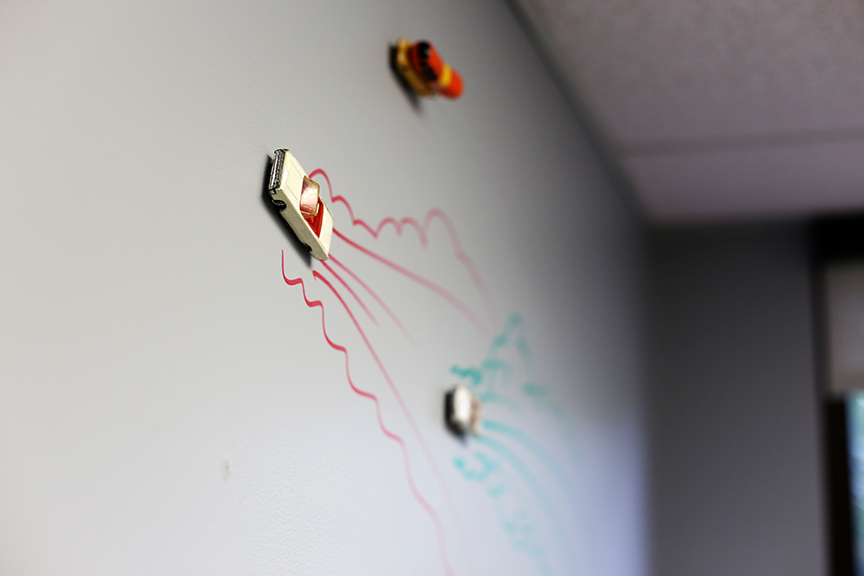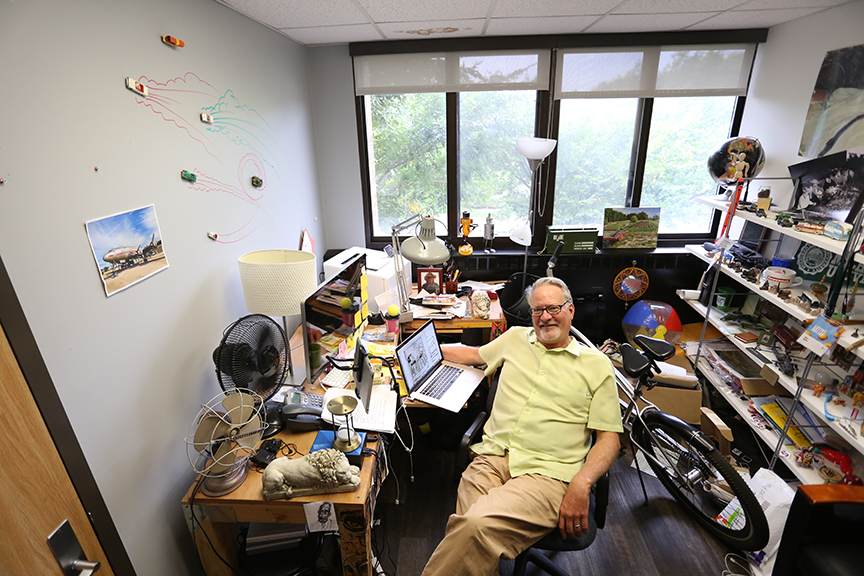Inspiring Students to Think Differently, Media Sandbox Director Karl Gude Leaves a Lasting Impression on MSU
A fleet of tiny jets hovers over an office door, and each toy jet appears to be in motion, as it sets its own flight pattern. The sketch illustrates the unique personality of the instructor inside, Karl Gude, and the way he sets creativity free for his students.
“With visuals, you create instant understanding,” said Gude, a professor of practice and director of Media Sandbox. “A lot of people are visual learners. They’re engaged much more by a visual than a story.”
Working in journalism as a visual storyteller, Gude held positions as the director of information graphics for Newsweek and The Associated Press, as well as other major news outlets. Drawing out complex news topics in ways that the public could understand, he led teams to create compelling infographics on deadline, covering some of the top news stories of his time.
“An infographic is a graphical display of data that explains things better than words alone can do. Having an infographic go with an article, like in a magazine, creates another entry point to the story,” said Gude. “It’s all very visual, like troop movements in Iraq, an assassination attempt, or the death of a company—a timeline with the DOW, and the new CEOs, and how they changed the company at different points in time.”
In 2006, Gude brought this savvy in visual storytelling to MSU’s College of Communication Arts and Sciences. He would go on to become the director of Media Sandbox in 2016, building up the integrated media arts program alongside Jeana-Dee Allen, an adjunct who will lead the program forward. For his work, the college presented Gude with the Faculty Impact Award in 2013, and MSU presented him with the Quality in Undergraduate Teaching Award in 2017. In December, he celebrated his retirement from a storied career.
“The mention of Karl always brings a smile,” said Dr. Lucinda Davenport, who previously directed the MSU School of Journalism. “Students will miss having him as an instructor who instills creativity in thinking and goodwill in actions. I’ll miss him, and his cheery disposition and amazing ability to motivate student learning.”
_0.png)
The Sketch Artist
An avid sketch artist, cartoonist, and painter, who also writes for the Huffington Post, Gude has presented on visual storytelling at South by Southwest (SXSW) and TEDx Talks in Detroit, Lansing and Midland. He has consulted with a wide variety of organizations and government agencies, including the CIA.
At ComArtSci, he taught not only illustration and graphics, but also social media marketing, creativity, and complex problem solving.
Gude first discovered a passion for teaching when he lived with his grandparents in Bogotá, Colombia, where he grew up.
“I wound up teaching English as a second language down there to adults, at 19 and 20 years old, and I really loved it,” he said. “I loved commanding a classroom.”
For his part, Gude had never gone to college. He blazed his own path, in a relentless rhythm of trial and error. A self-taught artist, he would also become known as a hardworking professional.
“Had I gone to college, I would have learned a lot without having tripped on my feet to learn it,” said Gude. “Now, I really respect learning in a university environment, because it actually makes the path better.”
With more guidance, Gude believes he could have avoided some of the pitfalls and made mistakes that would've had more impact on his growth in the long run.
“Then you can make mistakes elsewhere that are much more relevant and much bigger learning experiences.” Gude doesn’t believe he was born with natural talents. Instead, he said his creativity was something that had to be practiced and honed over time. “Over the years, if you really work hard with a mission, and you learn and grow from your mistakes and your failures, and some of your sketches are successful along the way, you start to think, ‘Hey, that didn’t suck! I think I’ll keep going.’”

On the Cutting Edge of Visual Arts
Working on the cutting edge of news design, Gude covered breaking stories with his news teams. From the Oklahoma City Bombing to the fall of the World Trade Center, he witnessed harrowing events first-hand.
"One of my greatest pleasures in my career was working with some of the best graphic designers, illustrators, reporters, and researchers. My best work was always collaborative," said Gude.
The teams worked tirelessly to translate both informational articles and devastating tragedies into graphics that the public could quickly grasp and understand. Their work ranged from mapping the paths of terrorists, to diagramming the processes of a nuclear reactor before an explosion and detailing the impact of radiation on the local community.
“During the span of my career, graphic journalism went from the drawing table, to the early computers, to this seriously sophisticated software. With visual communication, you really have to be on top of emerging media," he said. “In journalism, you don’t punch a clock. You just work all the time."
Not only did he work long hours and try to outpace the competitors, but he also began to feel the impact of the stories he covered. When he lost an intern in a terrorist bombing aboard a 747 aircraft, it took a personal toll.
“I was burning out after 27 years in journalism—two years in Washington, D.C., and 25 in New York City. Burning out on the tragedy. Burning out on the high pace. Burning out on the technology,” said Gude. “I realized I cannot keep up.”
From feature articles showcasing gardens to Olympic sports competitions, to the anatomy of the human heart, Gude illustrated the news. The graphic design technology changed faster than even the trade show exhibitors could predict.
“There was an emotional side, but also the technology was burning me out,” he said. “At that level, there’s a line of people at the door for your job, so you can’t really screw up too much.”
Known for his creative brilliance, Gude never wanted to lose his edge. He produced visual communications at the top of his field, and he never wanted his work to lose relevance or to shy away from the raw—and at times painful—truth of a story.
“In news, you start to realize that most stories are cyclical. I started feeling like there’s nothing I haven’t covered. You name it, I’ve diagramed it, untold hundreds of explanatory drawings,” said Gude. “The worst thing that can happen to a journalist is if you stop caring.”
A father to young children at the time, Gude was commuting three hours round-trip to direct the art department, working at all hours of the day and night. The time he missed with his family began to wear on him. He was ready for a change—and a break from New York City.
When the Future of Creativity Knocks
The opportunity to make an impact on the future of young creative people landed in the palm of Gude’s hand. MSU sent a physical letter to the staff at Newsweek, looking for someone to teach visual storytelling in the MSU School of Journalism.
Gude had nearly 30 years of experience as a working professional, but no formal education beyond high school. After some discussion, MSU offered to bring him on as one of their first professors of practice.
“I think it says volumes about MSU,” said Gude. “One of the things about students is that they’re hungry for practical knowledge, like industry knowledge from people who have been there. It says that our students and what they know matter. We want our students to have the greatest possible experience they can have.”
One of the best compliments he ever received came when a student told him that in a class of 500, he made the student feel like they were the only one in the room. That spark—the individual inspiration for each student—is at the heart of what Gude wants for his students.
“I’m never going to be the best quarterback in the NFL, but I was good enough to play the game,” he said. “That’s what I tell my students. If you believe in yourself and you work hard, you’ll find that you were good enough to play in the league you wanted to play in.”
Upon his retirement, Gude plans to work as a consultant for creativity, infographics, and visual storytelling, speaking at area organizations. He also plans to travel and immerse himself in art, exploring various new mediums that will challenge his abilities.
“My desire to do something was always greater than my fear of doing it,” said Gude. “If I was too afraid to do it, I must not want it very bad. The desire wasn’t enough to question the fog of fear.”
By Melissa Priebe

